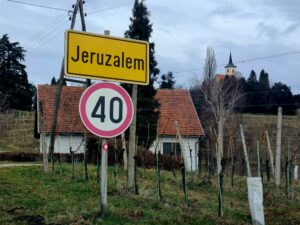You just never know what you’ll find in this city. You think you have it sussed. You think you know your streets. And then, you walk around a corner and literally, there’s a whole new world in front of you.

The sun is out, the temperatures have risen, the flowers are beginning to bloom, my nose is running and my eyes are itching. Spring is officially here. Next month, I have my second birthday as a home-owner. I signed the contract for my flat on April 15. Tax day in America. I didn’t move in until November so I’ve been in the neighbourhood for a year and some months. The ‘neighbourhood’ is the eighteenth-century suburb, now District VIII, which was originally called Alsó-Külváros (literally ‘Lower Suburb’). It was named after the heir of the Hungarian throne, Emperor Joseph 11 in 1777 – and now goes by the name Józsefváros. I thought I had it pretty much sussed… but I thought wrong.

Yesterday I went to the local garden centre to buy some plants to replace the ones that didn’t survive the winter in my window boxes. I’d been there before and have vague recollections of MC mentioning botanical gardens. So KG and myself thought we’d stop by to check them out… just for a look-see. What I thought were the Gardens turned out to be the Natural History Museum. The gardens themselves have a rather innocuous-looking entrance marked by a metal plaque. And, to be honest, from the outside looking it, it looks very much like a construction site. But curiosity won out. This is one of the three sites where Ferenc Molnár’s novel, A Pál utcai fiúk (1907) originally takes place: Füvészkert (botanical garden). (It’s a book worth reading: translated as the The Paul Street Boys.) So we paid our 600 ft (€2.20, $3.40, £2.00) and wandered around.
It’s the oldest of the gardens in Hungary, founded sometime between 1771 and 1847, depending on what you read!!! And apparently is home to 7000 plants including 150-year-old orchids. What struck me first was the noise – or rather the absence of noise. All we could here were birds chirping. It’s definitely undergoing some sort of renovation (we later saw a sign that reckons it’ll be finished in August 2010 so by next year perhaps, it should be done!) and parts of it are very decrepit. No matter. It’s an oasis in the heart of the city. The palmház (Palm House) is fascinating, if a little humid. It was built in 1866, renovated in 1966 and is amazingly colourful – right down to the piping! Other buildings were closed (we got there a little late in the day) and unfortunately, neither of us saw anything that might remotely resemble a café.
A return visit is in the diary for the summer! Maybe next time we might dress differently though as two old dears thought we looked as if we worked there!
Walking back to the flat through District VIII, we hit upon the Law Faculty buildings of Pázmány Péter Catholic University, a public university of the Catholic Church, recognised by the State, founded in the seventeenth century, and one of Hungary’s oldest and most prestigious institutions of higher education. And I never knew it was there! Perhaps more importantly, if somewhat mundane, there’s a rather nice-looking supermarket (if supermarkets can look nice) tucked away in the back streets behind my flat… again, one I’d never noticed/seen before. And less attractive are the 4000 0r so flats of the Corvinus development that are going up at an alarming rate. God only knows who is going to buy them. Another year or so and the neighbourhood will have changed, yet again! This city is one of the most vibrant in which I’ve lived – it’s the constant discovery of new places that makes living here so great.
Share this:
- Click to share on Twitter (Opens in new window)
- Click to share on Facebook (Opens in new window)
- Click to share on Pinterest (Opens in new window)
- Click to share on LinkedIn (Opens in new window)
- Click to share on Reddit (Opens in new window)
- Click to share on WhatsApp (Opens in new window)
- Click to share on Pocket (Opens in new window)
- Click to share on Telegram (Opens in new window)
- Click to email a link to a friend (Opens in new window)







2 Responses
Would like to be put on the email list of this blog—-thank you.
Hi Vicki – I see you’ve found the sign up/subscribe link. Enjoy!